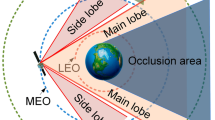Abstract
In this paper we consider the possibilities of navigation of spacecrafts designed to service artificial Earth satellites on the geostationary orbit and of space debris removal in the near-Earth space using the signals of Global Navigation Satellite Systems. We have formulated the methodology for estimation of the signals availability of navigation satellites on the geostationary orbit through the utilization of almanac of GPS and GLONASS. It has been demonstrated that in the case of reception of navigation signals, which are radiated by the antenna system within the limits of main lobe of the radiation pattern (RP), the availability of satellite navigation signals on the geostationary orbit is very low even if we utilize GPS and GLONASS simultaneously. We present the simulation results of the received on the geostationary orbit navigation satellites using the signals radiated in the main lobes in the range from ±13.8 to ±23.5° for the L1 frequency, from ±13.8 to ±26° for the L2/L5 frequencies and in the side lobes in the range from ±30 to ±60° of RP of the satellite antennas. The simulation of the navigation satellites available on the geostationary orbit is given on the 24-hour time interval. Presented results are illustrated by the calculations of number of visible satellites and by the geometric factor.
Similar content being viewed by others
References
NASA space science data coordinated archive. NASA, http://nssdc.gsfc.nasa.gov.
Spacecraft navigation. NASA jet propulsion laboratory, https://solarsystem.nasa.gov/basics/bsf13–1.php.
J. D. Kronman, “Experience using GPS for orbit determination of a geosynchronous satellite,” Proc. of the 13th Int. Tech. Meeting of Institute of Navigation, ION GPS 2000, 19–22 Sept. 2000, Salt Lake City, UT (2000), pp. 1622–1626.
Global Positioning System Standard Positioning Service Performance Standard. FAA, 4th ed. (Sept. 2008).
Geostationary orbit, https://en.wikipedia.org/wiki/Geostationary_orbit.
Ongoing Scientific Workshop “On Orbit Servicing. Problems and Technical Solutions”, http://www.elmiz.com/ en/seminars.
Frank H. Bauer, “GPS space service volume (SSV) ensuring consistent utility across GPS design builds for space users,” 15th PNT Advisory Board Meeting, 11 Jun. 2015, http://www.gps.gov/governance/advisory/meetings/2015–06/.
Dale A. Force, “Individual global navigation satellite systems in the space service volume,” ION Int. Tech. Meeting, 2013, http://ntrs.nasa.gov/archive/nasa/casi.ntrs.nasa.gov/20130011788.pdf.
Willard A. Marquis, Daniel L. Reigh, “The GPS block IIR and IIR-M broadcast L-band antenna panel: Its pattern and performance,” Navigation 62, No. 4, 329 (2015). DOI: 10.1002/navi.123.
The Navigator GPS Receiver. National Aeronautics and Space Administration, http://itpo.gsfc.nasa.gov/wp-content/uploads/gsc_14793_1_navigator.pdf.
Global positioning system directorate systems engineering and integration. Interface Specification IS-GPS-200. Navstar GPS Space Segment Navigation user Interfaces, FAA (24.09.2013).
Author information
Authors and Affiliations
Corresponding author
Additional information
ORCID: 0000-0003-4467-4245
Original Russian Text © V. Konin, F. Shyshkov, 2016, published in Izvestiya Vysshikh Uchebnykh Zavedenii, Radioelektronika, 2016, Vol. 59, No. 12, pp. 43–49.
About this article
Cite this article
Konin, V., Shyshkov, F. Autonomous navigation of service spacecrafts on geostationary orbit using GNSS signals. Radioelectron.Commun.Syst. 59, 562–566 (2016). https://doi.org/10.3103/S0735272716120049
Revised:
Published:
Issue Date:
DOI: https://doi.org/10.3103/S0735272716120049




